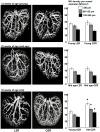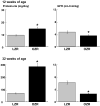Progressive renal vascular proliferation and injury in obese Zucker rats
- PMID: 20536738
- PMCID: PMC2924614
- DOI: 10.1111/j.1549-8719.2010.00020.x
Progressive renal vascular proliferation and injury in obese Zucker rats
Abstract
Objective: Obesity, an independent risk factor for chronic kidney disease, may induce renal injury by promoting inflammation. Inflammatory cytokines can induce neovascularization in different organs, including the kidneys. However, whether obesity triggers renal neovascularization and, if so, its effect on renal function has never been investigated.
Methods: Blood pressure, proteinuria, and glomerular filtration rate (GFR) were measured in vivo. Renal microvascular (MV) architecture was studied by 3D micro-CT in lean and obese Zucker rats (LZR and OZR, n = 7/group) at 12, 22, and 32 weeks of age. Renal inflammation was assessed by quantifying interleukin (IL)-6, tumor necrosis factor (TNF)-alpha, and ED-1 expression, as renal fibrosis in trichrome-stained cross-sections.
Results: Mild inflammation and lower GFR was only observed in younger OZR, without renal fibrosis or changes in MV density. Interestingly, renal MV density increased in OZR at 32 weeks of age, accompanied by pronounced increase in renal IL-6 and TNF-alpha, ED-1+ cells, proteinuria, decreased GFR, and fibrosis.
Conclusions: This study shows increased renal cortical vascularization in experimental obesity, suggesting neovascularization as an evolving process as obesity progresses. Increased renal vascularization, possibly triggered by inflammation, may reflect an initially compensatory mechanism in obesity. However, increased inflammation and inflammatory-induced neovascularization may further promote renal injury as obesity advances.
Figures




Similar articles
-
Role of the Renal Microcirculation in Progression of Chronic Kidney Injury in Obesity.Am J Nephrol. 2016;44(5):354-367. doi: 10.1159/000452365. Epub 2016 Oct 22. Am J Nephrol. 2016. PMID: 27771702 Free PMC article. Review.
-
Effects of salt rich diet in the obese Zucker rats: studies on renal function during isotonic volume expansion.Clin Exp Hypertens. 2004 Jan;26(1):55-67. doi: 10.1081/ceh-120027331. Clin Exp Hypertens. 2004. PMID: 15000297
-
Tesaglitazar, a dual peroxisome proliferator-activated receptor agonist (PPAR alpha/gamma), improves metabolic abnormalities and reduces renal injury in obese Zucker rats.Nephron Exp Nephrol. 2010;114(2):e61-8. doi: 10.1159/000254567. Epub 2009 Nov 4. Nephron Exp Nephrol. 2010. PMID: 19887847
-
ACE inhibition and AT1 receptor blockade prevent fatty liver and fibrosis in obese Zucker rats.Obesity (Silver Spring). 2008 Apr;16(4):770-6. doi: 10.1038/oby.2007.114. Epub 2007 Jan 24. Obesity (Silver Spring). 2008. PMID: 18239590
-
The Zucker rat model of obesity, insulin resistance, hyperlipidemia, and renal injury.Hypertension. 1992 Jan;19(1 Suppl):I110-5. doi: 10.1161/01.hyp.19.1_suppl.i110. Hypertension. 1992. PMID: 1730447 Review.
Cited by
-
Microvascular disease precedes the decline in renal function in the streptozotocin-induced diabetic rat.Am J Physiol Renal Physiol. 2012 Feb 1;302(3):F308-15. doi: 10.1152/ajprenal.00421.2011. Epub 2011 Oct 26. Am J Physiol Renal Physiol. 2012. PMID: 22031855 Free PMC article.
-
Potential renoprotective effects of piceatannol in ameliorating the early-stage nephropathy associated with obesity in obese Zucker rats.J Physiol Biochem. 2016 Sep;72(3):555-66. doi: 10.1007/s13105-015-0457-1. Epub 2015 Dec 10. J Physiol Biochem. 2016. PMID: 26660756
-
Sympathetic nervous system inhibition enhances cardiac metabolism and improves hemodynamics and glucose-insulin dynamics in obese and lean rat models.Sci Rep. 2025 Jan 2;15(1):503. doi: 10.1038/s41598-024-84218-1. Sci Rep. 2025. PMID: 39747975 Free PMC article.
-
Role of the Renal Microcirculation in Progression of Chronic Kidney Injury in Obesity.Am J Nephrol. 2016;44(5):354-367. doi: 10.1159/000452365. Epub 2016 Oct 22. Am J Nephrol. 2016. PMID: 27771702 Free PMC article. Review.
-
A Boolean Model of Microvascular Rarefaction to Predict Treatment Outcomes in Renal Disease.Sci Rep. 2020 Jan 16;10(1):440. doi: 10.1038/s41598-019-57386-8. Sci Rep. 2020. PMID: 31949240 Free PMC article.
References
-
- Hedley AA, Ogden CL, Johnson CL, et al. Prevalence of overweight and obesity among US children, adolescents, and adults, 1999–2002. Jama. 2004 Jun 16;291(23):2847–2850. - PubMed
-
- Eckel RH, Barouch WW, Ershow AG. Report of the National Heart, Lung, and Blood Institute-National Institute of Diabetes and Digestive and Kidney Diseases Working Group on the pathophysiology of obesity-associated cardiovascular disease. Circulation. 2002 Jun 18;105(24):2923–2928. - PubMed
-
- Kramer H. Obesity and chronic kidney disease. Contrib Nephrol. 2006;151:1–18. - PubMed
-
- Prevalence of chronic kidney disease and associated risk factors--United States, 1999–2004. MMWR Morb Mortal Wkly Rep. 2007 Mar 2;56(8):161–165. - PubMed
-
- Bosma RJ, Krikken JA, Homan van der Heide JJ, et al. Obesity and renal hemodynamics. Contrib Nephrol. 2006;151:184–202. - PubMed
Publication types
MeSH terms
Substances
Grants and funding
LinkOut - more resources
Full Text Sources
Medical

